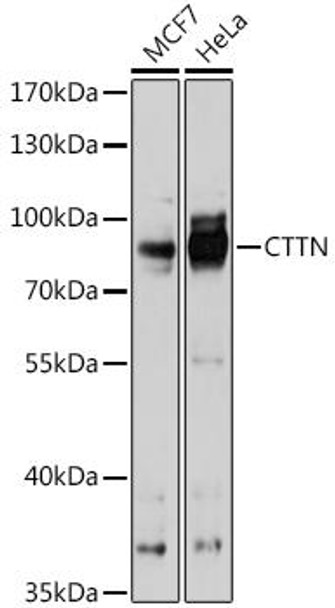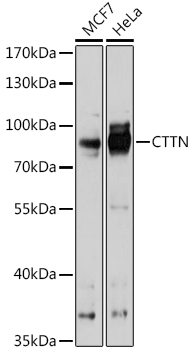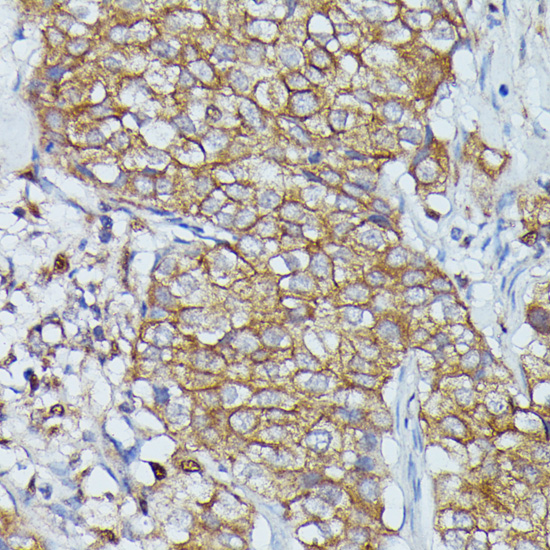Anti-CTTN Antibody (CAB15054)
- SKU:
- CAB15054
- Product type:
- Antibody
- Reactivity:
- Human
- Reactivity:
- Mouse
- Reactivity:
- Rat
- Host Species:
- Rabbit
- Isotype:
- IgG
- Antibody Type:
- Polyclonal Antibody
- Research Area:
- Cell Biology
Description
| 抗体名: | Anti-CTTN Antibody |
| 抗体コード: | CAB15054 |
| 抗体サイズ: | 20uL, 50uL, 100uL |
| 申し込み: | WB IHC IF |
| 反応性: | Human, Mouse, Rat |
| 宿主種: | Rabbit |
| 免疫原: | Recombinant fusion protein containing a sequence corresponding to amino acids 1-200 of human CTTN (NP_612632.1). |
| 申し込み: | WB IHC IF |
| 推奨希釈: | WB 1:500 - 1:2000 IHC 1:50 - 1:100 IF 1:50 - 1:100 |
| 反応性: | Human, Mouse, Rat |
| ポジティブサンプル: | MCF7, HeLa |
| 免疫原: | Recombinant fusion protein containing a sequence corresponding to amino acids 1-200 of human CTTN (NP_612632.1). |
| 精製方法: | Affinity purification |
| ストレージバッファ: | Store at -20'C. Avoid freeze / thaw cycles. Buffer: PBS with 0.02% sodium azide, 50% glycerol, pH7.3. |
| アイソタイプ: | IgG |
| 順序: | MWKA SAGH AVSI AQDD AGAD DWET DPDF VNDV SEKE QRWG AKTV QGSG HQEH INIH KLRE NVFQ EHQT LKEK ELET GPKA SHGY GGKF GVEQ DRMD KSAV GHEY QSKL SKHC SQVD SVRG FGGK FGVQ MDRV DQSA VGFE YQGK TEKH ASQK DYSS GFGG KYGV QADR VDKS AVGF DYQG KTEK HESQ RDYS KGFG GKYG |
| 遺伝子ID: | 2017 |
| Uniprot: | Q14247 |
| セルラーロケーション: | Cell junction, Cell membrane, Cell projection, Cytoplasm, Cytoplasmic side, Membrane, Peripheral membrane protein, cell cortex, clathrin-coated pit, cytoskeleton, dendrite, dendritic spine, focal adhesion, lamellipodium, podosome, ruffle |
| 計算された分子量: | 57kDa/61kDa/70kDa |
| 観察された分子量: | 85kDa |
| 同義語: | CTTN, EMS1, cortactin |
| バックグラウンド: | This gene is overexpressed in breast cancer and squamous cell carcinomas of the head and neck. The encoded protein is localized in the cytoplasm and in areas of the cell-substratum contacts. This gene has two roles: (1) regulating the interactions between components of adherens-type junctions and (2) organizing the cytoskeleton and cell adhesion structures of epithelia and carcinoma cells. During apoptosis, the encoded protein is degraded in a caspase-dependent manner. The aberrant regulation of this gene contributes to tumor cell invasion and metastasis. Three splice variants that encode different isoforms have been identified for this gene. |
| UniProt Protein Function: | Cortactin: a cytoskeletal protein that that is involved in coordinating actin reorganization during cell movement. Localizes at the leading edge of lamellipodia during cell migration. Its amino-terminal acidic domain associates with the Arp2/3 and WASP complex at F-actin branches. The central region of the protein contains six repeats of 37 amino acids that are important in F-actin binding and cross-linking. The carboxy-terminus contains a proline-rich region and an SH3 domain that can interact with numerous scaffolding proteins, such as CortBP1 and Shank3. Cortactin may play a role in the organization of transmembrane receptors at postsynaptic densities (PSD) and tight junctions by linking scaffolding proteins to the actin network. It is degraded in a caspase-dependent manner during apoptosis. It is overexpressed in numerous cancers with poor patient prognosis. It may contribute to tumor cell invasion and metastasis. Two splice variant isoforms have been identified. |
| UniProt Protein Details: | Protein type:Actin-binding; Cytoskeletal; Motility/polarity/chemotaxis Chromosomal Location of Human Ortholog: 11q13 Cellular Component: actin filament; cell cortex; coated pit; cortical cytoskeleton; cytoplasm; cytoskeleton; focal adhesion; Golgi apparatus; growth cone; intracellular membrane-bound organelle; lamellipodium; plasma membrane; ruffle; voltage-gated potassium channel complex Molecular Function:profilin binding; protein binding Biological Process: actin cytoskeleton reorganization; cell motility involved in cell locomotion; focal adhesion formation; intracellular protein transport; neurite morphogenesis; positive regulation of actin filament polymerization; positive regulation of smooth muscle contraction; receptor-mediated endocytosis; regulation of axon extension |
| NCBI Summary: | This gene is overexpressed in breast cancer and squamous cell carcinomas of the head and neck. The encoded protein is localized in the cytoplasm and in areas of the cell-substratum contacts. This gene has two roles: (1) regulating the interactions between components of adherens-type junctions and (2) organizing the cytoskeleton and cell adhesion structures of epithelia and carcinoma cells. During apoptosis, the encoded protein is degraded in a caspase-dependent manner. The aberrant regulation of this gene contributes to tumor cell invasion and metastasis. Three splice variants that encode different isoforms have been identified for this gene. [provided by RefSeq, May 2010] |
| UniProt Code: | Q14247 |
| NCBI GenInfo Identifier: | 215273892 |
| NCBI Gene ID: | 2017 |
| NCBI Accession: | Q14247.2 |
| UniProt Secondary Accession: | Q14247,Q8N707, Q96H99, |
| UniProt Related Accession: | Q14247,AAB26248 |
| Molecular Weight: | 57,467 Da |
| NCBI Full Name: | Src substrate cortactin |
| NCBI Synonym Full Names: | cortactin |
| NCBI Official Symbol: | CTTN |
| NCBI Official Synonym Symbols: | EMS1 |
| NCBI Protein Information: | src substrate cortactin |
| UniProt Protein Name: | Src substrate cortactin |
| UniProt Synonym Protein Names: | Amplaxin; Oncogene EMS1 |
| Protein Family: | CTTNBP2 N-terminal-like protein |
| UniProt Gene Name: | CTTN |
| UniProt Entry Name: | SRC8_HUMAN |




